18th Century French Paintings in the Louvre Museum
The French 18th century is historically a century of changes. It was also the case in arts. Discover this attaching and shining period with a licensed guide lecturer thanks to our 2-hour Louvre 18th-century French painting private tour.
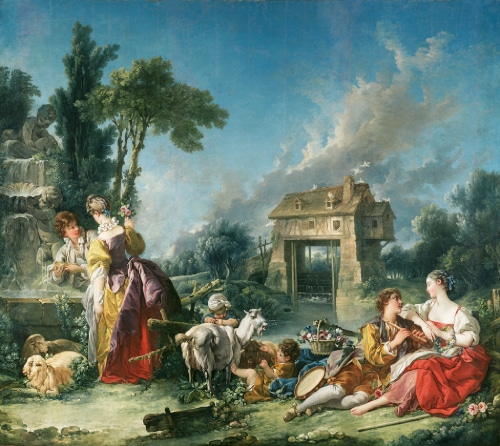
François Boucher is with Antoine Watteau and Honoré Fragonard a reference for 18th-century Rococo. Le Louvre owns a lot of Boucher paintings as pastoral landscapes with a watermill, a popular theme also displayed in other museums as on the photo (L.A. Getty version).
Louvre 18th century French Paintings private tour essentials
From 120 € for 1 to 2 people + 25 € for any extra person
- +/- 2-hour guided tour in English
- Genuine private tour = your party only (6 people max.)
- Postgraduate (MPhil) certified French national guide
- Flexible schedule
- Availability: not on Mondays, Tuesdays, Wednesdays
- Easy meeting point inside the Museum below the pyramid
- Skip-the-line ticket to buy online (22 € per adult)
Skip-the-line ticket clarification: they are just standard online tickets.
KNOW MORE / BOOK NOW
Your Private Tour Guide in the Louvre
Certified French national guide
BA, Magna Cum Laude, Heritage Developpement & Preservation from Conservatoire des Arts et Métiers
Postgraduate from Paris Dauphine-PSL University
What’s in the tour?
Enlightenment
Preromanticism
Drawing Versus Color
Rocaille & Rococo
Neo-classicism
Revolution
The Tour Masterpieces
“The Embarkation for Cythera” & “Pierrot” by Watteau; “Susanna at the Bath” by Jean-Baptiste Santerre; “The Ray” & “The Buffet” by Chardin; “Les attributs des arts” by Anne Vallayer-Coster, “Diana Leaving the Bath” & “Le Déjeuner” by François Bouchet; “Scenes of the harbors of France” series by Joseph Vernet; “Peace bringing back abundance” by Elisabeth Vigée Lebrun; “The Bolt” & “Coresus Sacrificing Himself to Save Callirhoe” by Fragonard; “Broken Pitcher” by Jean-Baptiste Greuze; “Psyche Receiving Cupid’s First Kiss” and “Empress Marie-Louise” by François Gérard; “Portrait of the young girl” by Pierre-Narcisse Guérin; “Portrait of Madeleine” by Marie-Guillemine Benoist and some amazing portraits and history paintings by Jacques Louis David.
A selection of carefully selected other masterpieces to better explain the historical context and artistic evolution of the French Revolution century.
Why the 18th Century French Painting?
Because the French 18th century is called “le siècle des lumières, ” literally the “century of lights,” (in English the Age of Enlightenment), a brilliant period then.
Nevertheless, this century is also a century of great changes in France. A century began with Louis XIV’s absolutism, which later saw France losing its dominant position for the benefit of England, and finally arrived the French Revolution, the fall of the monarchy, and the beginning of the Napoleonic period.
You will discover in this tour that the world of painting was not outdone in terms of changes. The French 18th century in painting is astonishing: a firework of innovations under the strict control of the Royal Academy of Painting and Sculpture.
The Royal Academy was suppressed in August 1793 following a request of Jacques Louis David as a deputy of the National Convention; it was seven months after the execution of Louis XVI, two months before the one of Marie-Antoinette—the beginning of a new story.
Content of the Tour
- The painters of the end of the Reign of Louis XIV, Jouvenet, de la Fosse, Coypel, Rigaud, Largillière, etc., and the debate between Poussinists and Rubenists
- The invention of the “fête galante“ (courtship party) to classify Watteau’s works
- The Frivolity of the Regency and the Reign of Louis XV: the Rococo Style with Francois Boucher, its most famous representant
- The Dutch golden age influence: still lifes, landscape, genre painting
- Simon Chardin’s still lifes
- The landscape and marines by Joseph Vernet
- The moralizing genre painting of Greuze
- The impact of the new ideas of the Enlightenment on the arts
- Pioneering French women painters making History
- How the notion of portrait changed during the 18th century
- The multifaceted talents of Fragonard, the pupil of Boucher and Chardin
- The Neoclassical reaction
- The early stirring of Romanticism with the ruin paintings (capricci) of Hubert Robert
Two Paintings for The Rococo Timeline
The Embarkation for Cythera by Jean-Antoine Watteau is considered the most significant milestone for the beginning of the Rococo period. Painted in 1717, only two years after the death of Louis XIV, the painting symbolizes the liberation of the French noble class from all the rules of 72 years of the old king’s reign—a new era of endless pleasure-seeking, the regency period. The masterpiece was Watteau’s reception piece to the French Royal Academy of Painting and Sculpture; they invented a new category for the painting: “fêtes galantes” (courtship party).
The Bolt (French: Le Verrou), a gallant scene painted by Jean-Honoré Fragonard in 1777, is one of the last iconic works of the ending Rococo period. Fragonard continued to serve the Rocco style lately despite having received strong signals to abandon it for Neoclassicism, the next dominant art style (a few years before Fragonard’s Rocco paintings for the apartments of Mme du Barry, the last mistress of Louis XV, were refused.)
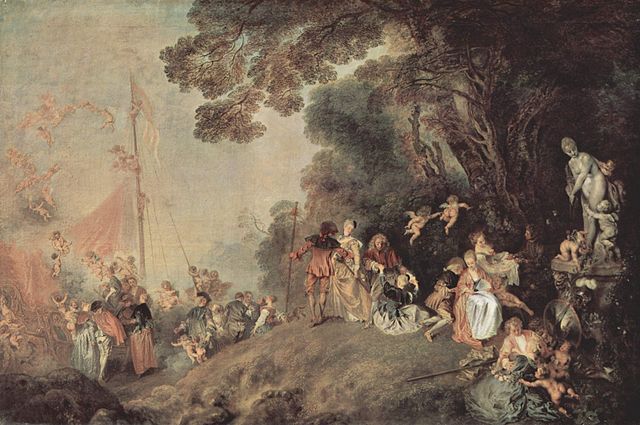
The Embarkation for Cythera (“L’embarquement pour Cythère”) by Jean-Antoine Watteau. Photo of the third version of the work, which is in Berlin (Charlottenburg Palace). The second version, the most famous one, is in the Louvre. The Yorck Project – GNU Free Documentation License.

The Bolt (French: Le Verrou), also known as The Lock by Fragonard. Credit The Yorck Project – GNU Free Documentation License.
An 18th Century Mona Lisa? The portrait of Madame de Sorquainville
Pierre Rosenberg (Member of the Académie Française, président-directeur of musée du Louvre from 1994 to 2001) wrote in his Dictionnaire amoureux du Louvre (2007) about the portrait of Madame de Sorquainville “Son sourire ? Celui d’une Joconde du XVIIIe siècle, d’un XVIIIe qui parlait et pensait français… “.
This portrait should be more famous than it is. It is clearly one of the jewels of the Louvre. Painted by Jean Baptiste Perronneau, the challenger of Quentin de la Tour in the Pastel, the Canvas, despite being oil realized, reflects many aspects of the 18th century’s most desired portrait technique.
You have to be in situ to understand why it can be compared to Mona Lisa, The quietness, the attitude, the eyes, the smile…
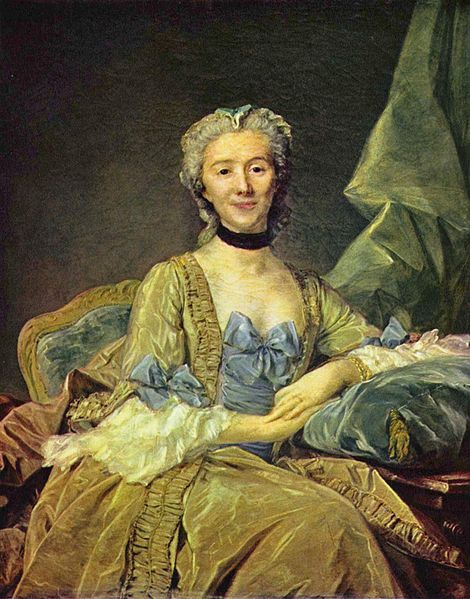
Madame de Sorquainville by Jean-Baptiste Perronneau. Credit The Yorck Project – GNU Free Documentation License.
Few Glimpses of the Tour
Two Attaching Painters of the 18th Century
Jean-Baptiste Greuze was an exception; in the time of a riot of nudity by François Boucher, he developed antinomic moralizing genre subjects influenced by seventeenth-century Dutch painting.
The most famous of these paintings, “L’Accordée de Village,” is among others in the Louvre. Jean-Baptiste Greuze also painted charming pictures of young women with a subtle implicit sense, as in the “Broken Pitcher.“
Elisabeth Vigée Lebrun as Greuze had a fantastic success, in her case in portrait painting. She was even the favorite painter of Queen Marie-Antoinette herself. Both painters’ academy reception painting pieces, “Peace bringing back abundance” and “Septime Severe et Caracalla,” are shown in the Louvre galleries.
We will see how talent was not always sufficient to get the favor of the famous French art institution.
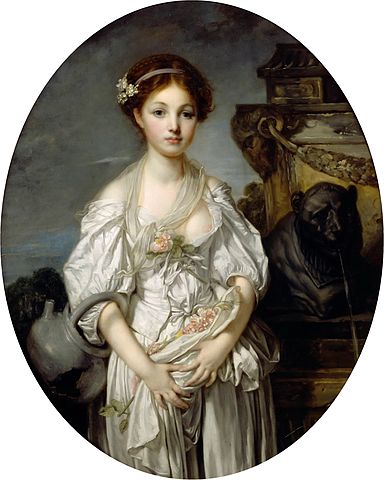
The broken pitcher by J.B Greuze . Credit The Yorck Project – GNU Free Documentation License.
Don’t miss the opportunity to follow our Louvre 18th-century French painting tour
to discover the artistic side of the French century of light!
Prepare Your 18th-Century French Painting Guided Tour
Learn already how to recognize Rococo from previous Baroque:
- Subject: from sacred to frivolity
- Portrait: from formal representation to character & personality
- Form: from symmetry to asymmetrical curves
The new style is also recognizable by the wide use of flower ornamentation and warm pastel colors (such as light blue or green).
More 18th-Century French Paintings with the Orléans Pastels Collection
One of the most famous Rococo and Enlightenment-era art forms is missing in the Louvre 18th Century galleries: the pastel. Despite owning the first pastel collection in France, the Louvre rarely shows them because of their fragility, discouraging their exhibition in the world’s most visited museum.
Nevertheless, if you are an 18th-century fan, France’s second-largest pastel collection is shown as part of the permanent collection of quieter Orléans Museum of Fine Arts at only a little more than 100 km from Paris.
More 18th-Century at the Louvre MUSEUM the decorative arts Galleries
The 18th-century art of the Louvre is not only about painting; the museum also houses in the north wing of the museum’s Cour Carrée, 35 galleries of over 23,00 square feet presenting the art of living at the French Court from Louis XIV to the French Révolution. This exceptional 18th-century decorative art collection. includes an incomparable array of masterpieces, from rugs and tapestries to royal furniture, jewelry, porcelain, and decorative paneling. The department was fully renovated in 2014, and the American Friends of the Louvre (AFL) raised $4 million to help renovate two key period rooms.
Other Louvre Paintings Tours You May Like
- Middle Age and Renaissance French painting
- 17th-century French Painting
- 18th-century French Painting
- 19th-century French Painting (first half only)
But, if you are also interested in the second half of the 19th century, you must add our Musée d’Orsay Private tour (covering the period from 1850 to 1914). Do not hesitate to contact us if you want to follow the entire cycle.
Things to know before Booking
Clarification: Skip-the-Line Tickets Are Just Standard Online Ones
Louvre website says "All visitors, including those entitled to free admission (including Paris Museum Pass bearer), must book a time slot. Buy your ticket online on www.ticketlouvre.fr... During off-peak times, there may also be a limited number of time slots for same-day visits available for booking at the museum. However ... to guarantee your entry ... we strongly advise booking your time slot in advance online." Conclusion no magic: During your time slot, you are entitled to enter the online booking security line, so yes, you skip the line... of those who come without a ticket!
Louvre Museum Tickets Fare
Museum tickets are not included in the tour price.
- Online Louvre tickets: 17 € per adult
- Free for all kids under 18 years old
- Free under 26 years old for the European Union residents
Restrictions
- Private tour means a tour for you & your party only, not that the museum is privatized.
- Tour duration & content are purely indicative, they may vary due to contingencies.
- In case of unexpected closed galleries you accept to follow a substitution content.
- Prices do not include transportation, food, drinks or any other extra services.
Attention Points
- Check the Louvre galleries closure schedule before planning your Louvre coming
- Tour on foot in Louvre's huge galleries, so good health & comfortable shoes are mandatory
- Photos are authorized, but without flash. Selfie sticks are not allowed.
- WARNING proof of ID is mandatory as tickets are nominative!
- WARNING print your tickets or at least upload them before coming to the Louvre (last minute problem uploading tickets may spoil the tour)
Meeting Point
Easy one Inside or outside the museum (detail during booking)
Access: Metro Line 1 station Palais-Royal
Book your Louvre Private Tour
confirmation (email)
Louvre 18th-Century French Painting Private tour
Extended tour (2 hours)For 1 to 2 people + 25€ for any extra person
A group of maximum 6 people exclusively yours
Louvre ticket not included
Meeting Point inside the Museum
English language
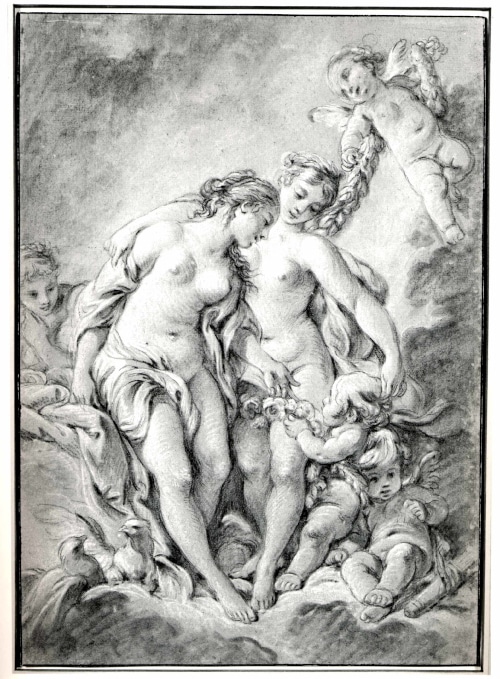
Nude was also a recurrent theme in Boucher’s Rococo.
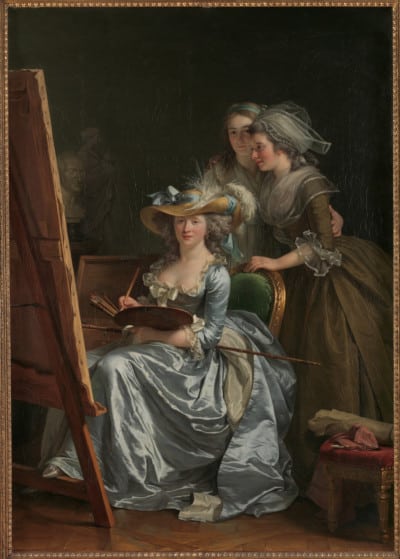
Self-portrait of Adelaïde Labille-Guiard. She was admitted to the Académie on the same day that her rival Élisabeth Louise Vigée Le Brun. Credit: The Metropolitan Museum of Art, New York, Gift of Julia A. Berwind, 1953.


